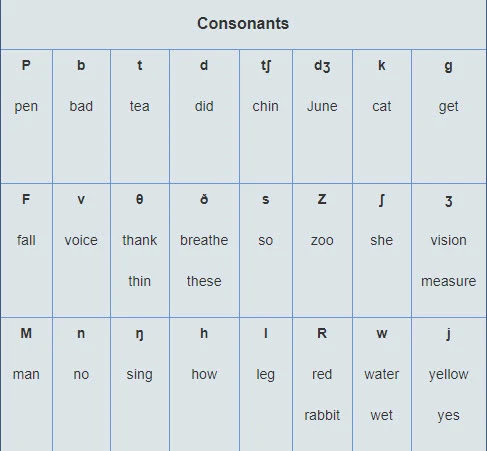The Phonemic Chart
 |
| The International Phonetic Alphabet (IPA) |
The International Phonetic Alphabet (IPA)
As spelling and sounds are different, we use a special script called “phonemic script”
to transcribe spoken language. For teaching purposes, English sounds are often displayed in the form of a phonemic chart, also known as the International Phonetic Alphabet (IPA). Here is a copy of the phonemic chart that you can download and / or print to use in class or for personal study.
Consonant sounds
Consonant sounds are formed when the moveable parts of the mouth, including the tongue and lips, obstruct the airflow from the lungs.Try pronouncing these sounds, and decide where the obstruction is occurring:
/m/ as in man
/v/ as in van
/n/ as in nan
/t/ as in tan
/r/ as in ran
/k/ as in can
 |
| Consonants |
Many of the consonants consist of “unvoiced” and “voiced” pairs. A voiced sound is made by activating the vocal cords. You can check this by putting your fingers on your throat to feel the vibration. In an unvoiced sound, the vocal cords aren’t used, so there is no vibration.
Vowel sounds
Vowel sounds mainly use the tongue and lips to modify the airflow through the mouth rather than obstructing it. Vowels can be “monophthongs” (single vowels) or “diphthongs” (a glide from one vowel to another). All vowels are voiced.
Here are the vowels of standard British English in phonemic script. |
| Vowel Sounds |
The schwa Sound
There’s a vowel sound that is so frequent in English that it has its own name: schwa.
The symbol for the schwa is /ə/.
It’s the unstressed, neutral vowel sound and can be represented in spelling by many different letters or combinations of letters. As schwa is such a small sound, many English learners have difficulty in hearing and saying it. It’s very important that you learn the sound, if you want to have a natural-sounding accent. It can be found at the start, in the middle, or at the end of a word.
Look at the following examples of the schwa. Remember the schwa symbol is /ə/.
Beginning position
agree - əgri:
obstruct- əbstrʌkt
offence- əfens
Middle position
entered - entərd
dinners- dɪnəz
amateur - æmətɜ:
End position
doctor - dɒktə
teacher - ti:ʧə
colour - kʌlə
💡 Remember 👉 This is a British pronunciation, as some differences occur in American, eg:
teacher - ˈtiːʧə Br.
teacher - tiʧər Amr.
Using the phonemic chart
To help you get more familiar with the script, look at the words given in phonemic. Using your chart, work out what each word is.
- keɪk
- mɑːstə
- mʌðə
- θæŋks
- sɪɡəˈret
- steɪʃn̩
- taʊəl
- krɪsməs
- ʃʊɡə
- wɪkɪd
Let me know the answers in the comments. If you liked the material and test, please feel free to share it with your friends (●'◡'●)


5 Comments
That's really awesome. I'm an English teacher. I like it. You nailed it. ����������
ReplyDeleteWow, sounds awesome and glad you liked the post. More are coming on the way for teaching English for foreign leanrners, so follow with me to keep posted.
Delete-cake
ReplyDelete-mastar
-mother
-thanks
-cigarette
-station
-towel
- Christmas
- sugar
- wicked
��
Amazing!
Delete👏👏👏
DeleteYour opinion matters, your voice makes us proud and happy. Your words are our motivation.